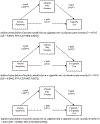Anxiety sensitivity, pain severity and co-use of cigarettes and e-cigarettes among adults with chronic pain
- PMID: 33675503
- PMCID: PMC11163874
- DOI: 10.1007/s10865-021-00210-4
Anxiety sensitivity, pain severity and co-use of cigarettes and e-cigarettes among adults with chronic pain
Abstract
Anxiety sensitivity (fear of potential negative consequences of anxiety-related symptoms/sensations) has been identified as a transdiagnostic factor in comorbid pain and nicotine dependence and evidence suggests that anxiety sensitivity may be indirectly associated with nicotine use via greater pain severity. Therefore, this study tested the hypothesis that anxiety sensitivity is associated with cigarette and e-cigarette use/co-use directly and indirectly via greater pain severity. Participants included 273 online survey respondents with chronic musculoskeletal pain (34% female; Mage = 32.9). Anxiety sensitivity was positively associated with cigarette smoking, e-cigarette use and cigarette/e-cigarette co-use (ps < .05). Furthermore, anxiety sensitivity was indirectly and positively associated with cigarette smoking, e-cigarette use and co-use via greater chronic pain severity. Pain severity may play an important role in associations between anxiety sensitivity and nicotine dependence and prospective research should examine temporal/causal effects of anxiety sensitivity in relation to pain severity and nicotine/tobacco use.
Keywords: Anxiety sensitivity; Dual users; Electronic cigarettes; Nicotine; Pain.
Conflict of interest statement
Figures
Similar articles
-
Longitudinal Associations Between Pain and Use of Cigarettes and E-cigarettes in the Population Assessment of Tobacco and Health (PATH) Study.Nicotine Tob Res. 2023 Feb 9;25(3):404-411. doi: 10.1093/ntr/ntac197. Nicotine Tob Res. 2023. PMID: 35965386 Free PMC article.
-
Differences in anxiety, depression and pain experience among adults with chronic low back pain as a function of nicotine product use.J Behav Med. 2025 Apr;48(2):331-340. doi: 10.1007/s10865-024-00547-6. Epub 2025 Jan 9. J Behav Med. 2025. PMID: 39789403
-
Pain intensity, e-cigarette dependence, and cessation-related outcomes: The moderating role of pain-related anxiety.Addict Behav. 2020 Dec;111:106548. doi: 10.1016/j.addbeh.2020.106548. Epub 2020 Jul 11. Addict Behav. 2020. PMID: 32745941 Free PMC article.
-
Current pain severity and electronic cigarettes: an initial empirical investigation.J Behav Med. 2019 Jun;42(3):461-468. doi: 10.1007/s10865-018-9995-7. Epub 2018 Nov 28. J Behav Med. 2019. PMID: 30488135
-
Nicotine Dependence among Current Cigarette Smokers Who Use E-Cigarettes and Cannabis.Subst Use Misuse. 2023;58(5):618-628. doi: 10.1080/10826084.2023.2177961. Epub 2023 Feb 27. Subst Use Misuse. 2023. PMID: 36852436 Free PMC article.
Cited by
-
Longitudinal Associations Between Pain and Use of Cigarettes and E-cigarettes in the Population Assessment of Tobacco and Health (PATH) Study.Nicotine Tob Res. 2023 Feb 9;25(3):404-411. doi: 10.1093/ntr/ntac197. Nicotine Tob Res. 2023. PMID: 35965386 Free PMC article.
-
Differences in Pain Severity and Interference between Latinx Combustible Cigarette Smokers and Dual Users with Current Pain.Behav Med. 2025 Jan-Mar;51(1):7-17. doi: 10.1080/08964289.2023.2290480. Epub 2023 Dec 19. Behav Med. 2025. PMID: 38112190
-
Nicotine, tobacco smoking, and pain in orthopedic trauma settings: a conceptual framework for practice and research.Arch Orthop Trauma Surg. 2025 Jun 30;145(1):357. doi: 10.1007/s00402-025-05963-0. Arch Orthop Trauma Surg. 2025. PMID: 40586842 Review.
-
Relationship between pain and nonopioid substance use in two national samples of cancer survivors.Cancer. 2025 Feb 15;131(4):e35701. doi: 10.1002/cncr.35701. Cancer. 2025. PMID: 39925086 Free PMC article.
-
Differences in anxiety, depression and pain experience among adults with chronic low back pain as a function of nicotine product use.J Behav Med. 2025 Apr;48(2):331-340. doi: 10.1007/s10865-024-00547-6. Epub 2025 Jan 9. J Behav Med. 2025. PMID: 39789403
References
-
- Allan NP, Raines AM, Capron DW, Norr AM, Zvolensky MJ, & Schmidt NB (2014). Identification of anxiety sensitivity classes and clinical cut-scores in a sample of adult smokers: results from a factor mixture model. Journal of Anxiety Disorders, 28, 696–703. 10.1016/j.janxdis.2014.07.006 - DOI - PMC - PubMed
-
- Andersson H, Ejlertsson G, & Leden I (1998). Widespread musculoskeletal chronic pain associated with smoking An epidemiological study in a general rural population. Scandinavian Journal of Rehabilitation Medicine., 30, 185–191. - PubMed
-
- Asmundson GJ, Norton PJ, & Veloso F (1999). Anxiety sensitivity and fear of pain in patients with recurring headaches. Behaviour Research and Therapy, 37, 703–713. - PubMed
-
- Avallone KM, & McLeish AC (2015). Anxiety sensitivity as a mediator of the association between asthma and smoking. Journal of Asthma, 52, 498–504. - PubMed
Publication types
MeSH terms
Grants and funding
LinkOut - more resources
Full Text Sources
Other Literature Sources
Medical


